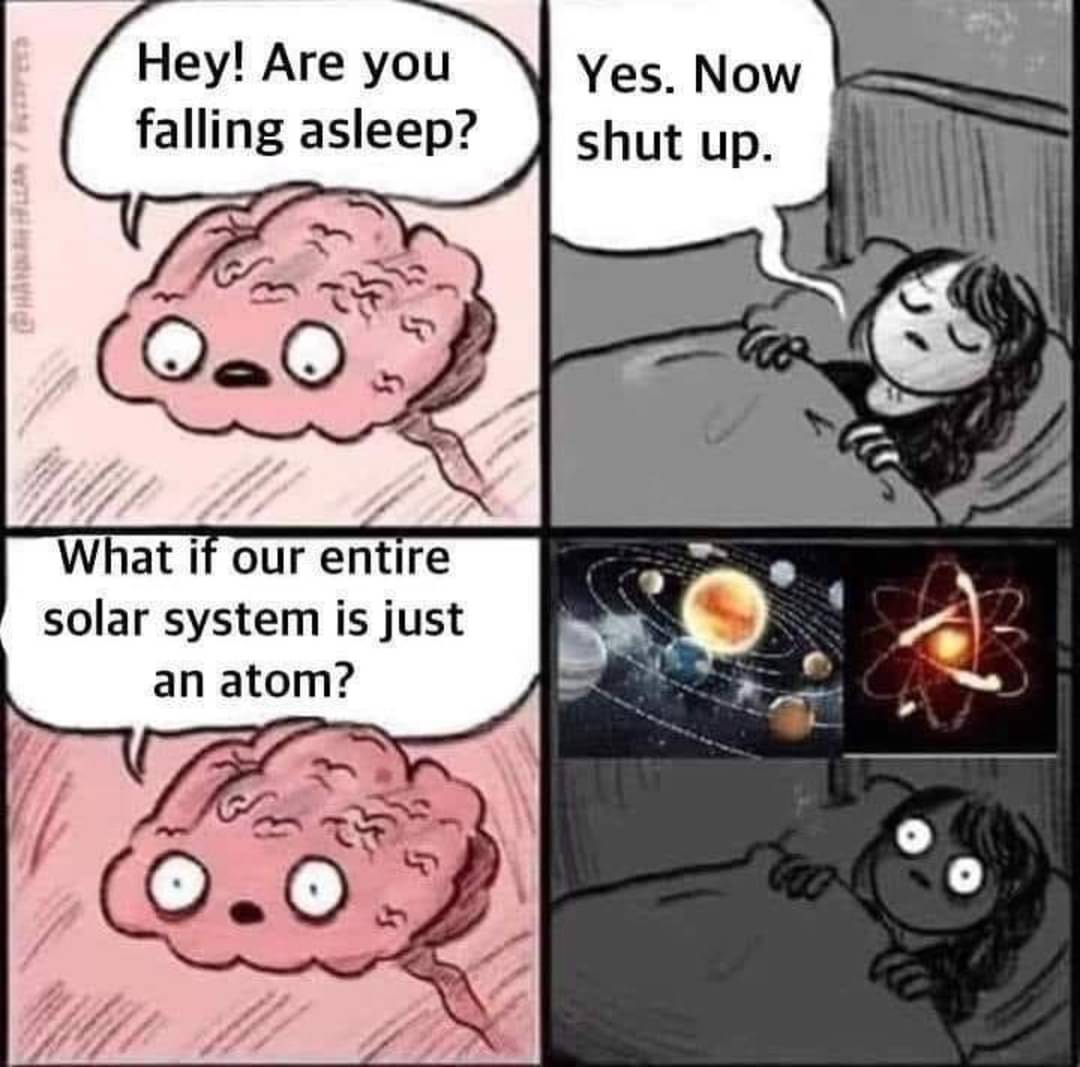this post was submitted on 04 Oct 2024
225 points (81.7% liked)
Science Memes
10923 readers
2317 users here now
Welcome to c/science_memes @ Mander.xyz!
A place for majestic STEMLORD peacocking, as well as memes about the realities of working in a lab.

Rules
- Don't throw mud. Behave like an intellectual and remember the human.
- Keep it rooted (on topic).
- No spam.
- Infographics welcome, get schooled.
This is a science community. We use the Dawkins definition of meme.
Research Committee
Other Mander Communities
Science and Research
Biology and Life Sciences
- [email protected]
- [email protected]
- [email protected]
- [email protected]
- [email protected]
- [email protected]
- [email protected]
- [email protected]
- [email protected]
- [email protected]
- [email protected]
- [email protected]
- [email protected]
- [email protected]
- [email protected]
- [email protected]
- [email protected]
- [email protected]
- [email protected]
- [email protected]
- [email protected]
- [email protected]
- [email protected]
- [email protected]
- !reptiles and [email protected]
Physical Sciences
- [email protected]
- [email protected]
- [email protected]
- [email protected]
- [email protected]
- [email protected]
- [email protected]
- [email protected]
- [email protected]
Humanities and Social Sciences
Practical and Applied Sciences
- !exercise-and [email protected]
- [email protected]
- !self [email protected]
- [email protected]
- [email protected]
- [email protected]
Memes
Miscellaneous
founded 2 years ago
MODERATORS
you are viewing a single comment's thread
view the rest of the comments
view the rest of the comments

See I agree with your last statement. I mean “any” is a stretch but yeah there probably are other systems involving distance based forces that we could draw similarities to chemistry from.
I guess the issue here is that my argument is there are similarities and your argument is that one shouldn’t point out similarities unless there are enough of them…?
Your first paragraph implies you thought I meant just setting these systems statically next to each other would create a stable orbit. You’re right, that would be wrong. But I don’t think I ever mentioned stationary combination. Furthermore, while regular chemistry could work like that, in the real world every atom is moving. The bonds form when atoms get close enough. This is why temperature increases chemical reactions. More motion means more “collisions” that aren’t really collisions but you get the picture.
Objects in space are also constantly in motion. If you want to bring two stellar systems together, you need to give them velocities relative to each other. Or as you put it, momentum. This could be enough to ensure a stable system but it requires that the velocities at least a roughly specific which is what I meant when I said system chemistry would be highly directional in my original comment.
As for magnets. You could say both atoms and magnetic systems run on similar forces. You could make the argument that they, like atoms, have components which are constantly in motion and that if perturbed enough one could overcome those forces and break the system into its individual components.
However the behavior of the system as a whole is not similar to atoms because it cannot form any bonds of any kind with other similar systems.
If you were able to find magnetic monopoles which may or may not exist, you could probably build a system that is much more atom like than a gravitational system. But with magnets that have dipoles, even a ferromagnetic material would be drawn to one pole or the other. I suppose you could get up to two ferromagnetic bodies to orbit a rotating bar magnet if the velocities and distances were right, but you wouldn’t be able to combine them because moving any magnet closer would disrupt the conditions needed for stability.
Magnets are much more sensitive than gravitational systems because the objects have to be large relative to the system and close together whereas gravitational systems can be ginormous like Alpha Centauri.
Anyway it’s fun to think about what exactly I would count as chemical like properties.
I’d say they are mostly just the following:
I think that covers it. So if you can find a system that fits those then I’d say there are similarities between them and atoms/chemistry. I will honestly be pretty excited if you do because it will be interesting.
I'd say, kind of... Yeah jackfruits are like apples but yellow(edit:the part you eat). And also big. And also tastes different. Also have spikes. But they are still like apples.
Sure you can imagine it like that, and one more note, the components of the units are very different on stellar system, unlike indifferentiable subatomic particles. This means you can't have any named atom since all of them are different. It also emmits energy from star. Still yes you could imagine it like an atom, and fit the crieterias you mentioned(which I think must include a bit more which would disqualify stellar systems from being atom, but that's your classification).
For another system which may fit your atomic desciption, we could also try scaling up the normal atom! That is, make electrically charged macroscopic bodies as nucleus and electrons. This I think in principle will work much better than gravitational atom. We can have repulsion as well as attraction which would be enough to balance out for stability. We would still get a planetary model(Rutherford model) of such an atom.
Also unfortunately, there aren't many forces in physics, so i'm afraid i can't find more analogous systems. Anyway thank you for the curious exploration<3